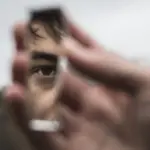We live in times where we are constantly bombarded with images of perfect bodies. When walking through the streets of any big city, it is difficult to prevent our eyes from landing on one of those giant advertisements that project the image of models or actors with dizzying silhouettes and flawless smiles.
Although This aesthetic ideal is unattainable for most people there are many who choose it as a reference to which they aspire, which ends up crashing into a very different and more mundane reality: all bodies are imperfect (even those of the aforementioned celebrities, adorned with the “plate and paint” of retouching). IT).
From this impossible aspiration arises the explicit rejection of physical variables as diverse as body hair, eye color/shape, hair density or even the alignment of teeth. In short, a repudiation of one’s own body and its naturalness arises.
In this article we will talk about body dysmorphia (and its subclinical forms), which constitutes a common problem (especially in industrialized countries) related to the erosion of self-esteem.
What is body dysmorphia?
Body dysmorphia (also known as dysmorphophobia or body dysmorphic disorder) is expressed, in general terms, as the explicit rejection of a specific attribute (or several) of the body.
It supposes a distortion in the self-perception process , which magnifies a small defect (invaluable in the eyes of others) or that directly identifies it where it is not. Below we will explore each of its fundamental symptoms.
1. Concern about physical defects that are insignificant to others
The person with body dysmorphia reports discomfort around a specific area of their body, this being a physical attribute to which they associate a negative emotional nuance. In this way, when she observes or thinks about herself, perceives overwhelming feelings that lead to dissatisfaction deep and persistent. His rejection gives you a great feeling of shame and inadequacy.
The regions of complaint are usually located on the face , especially highlighting the nose (due to its size or shape), the eyes (the color, inclination and drooping of the eyelids) and the skin (especially when traces of acne persist during adolescence or the first wrinkles are seen bordering lip corner). Additionally, hair is susceptible to rejection (due to its density or shine), as well as the shape or size of the head.
Body perception can also be compromised , with a special emphasis on the female chest or the curve of the waist. In this sense, it is common for breasts to be judged as very large or small, with an asymmetrical shape or undesirable characteristics (irregular areolas or with a color that is too light/dark), or excessively saggy (due to some discrete ptosis). Finally, the genitals, in men and women, can also be perceived in an aversive way (in very different parameters).
Subjects with body dysmorphia They report that at least two parts of their body are widely reprehensible to them , although these tend to fluctuate over time, moving to different and distant regions (up to seven or eight on average throughout life). It is necessary to remember that these are minimal or non-existent imperfections, which is why there is a massive self-awareness of one’s own body and an overestimation of the irregularities that occur in it in a normal situation.
Worries about physical imperfection take up a lot of time each day, so that a quarter of those affected report that thoughts about the subject last for eight hours or more a day. That is why they tend to experience them as invasive ideas, which come to the mind without the will being involved and which end up precipitating notable discomfort (sadness, fear of being rejected, anguish, frustration, etc.).
Studies on the disorder suggest that the age of onset is in adolescence , a period of life in which there is a heightened need to be accepted by the environment. Criticism from the group you belong to can be a clear trigger for the problem, which is supported through concealment and is only revealed to those considered absolutely trustworthy. This is why its diagnosis and treatment can take many years.
2. Behaviors of concern about one’s own appearance
As a consequence of these concerns about one’s own appearance, a series of strategies are usually developed aimed at minimizing the anxiety associated with it. In this sense, behaviors and mental acts are distinguished that cause momentary relief but that over time tend to increase difficult emotions linked to intrusive thinking.
Among the checking behaviors, the use of full-length or hand-held mirrors stands out, as well as the search for reflective surfaces in public or passage areas, with which to inadvertently explore the silhouette (the abdomen, legs or butt). Excessive grooming can also be carried out, in which an arsenal of cosmetic products is used aimed at hiding the details of the face on which the negative evaluation is projected.
Regarding mental acts, What is common is that the affected person constantly compares himself with others , stopping at the body parts of others that she rejects in herself. Thus, he can notice especially those who have the traits he would like, who represent isolated or exceptional cases, so the behavior ends up exacerbating his pain and increasing the feeling of strangeness or deformity (“why can’t I be like that? “).
All of these behaviors are difficult to resist or stop , arising automatically along with concern about imperfection. Thus, a relationship of a functional nature is established between the two: the thought causes discomfort, and the reaction (behavioral or mental) unsuccessfully pursues the goal of stopping or alleviating it.
In this relationship lies the basic mechanism for maintaining the problem, since the strategies used to eliminate suffering only work in the short term, but in the medium and long term they aggravate it.
3. Deterioration of daily life
Body dysmorphic disorder usually has a notable impact on the development of the daily life of those who suffer from it, extending to dimensions such as relationships or friendships, as well as academic and work areas. It is not uncommon for negative evaluations of specific aspects of the body to resonate the subjective ability to have a satisfactory sexual life which would translate into difficulties in establishing loving bonds of physical intimacy.
In severe cases, the problem (currently considered a somatic symptom disorder in the DSM-5) causes significant impairment of the social sphere as a whole, with persistent feelings that one is being watched or that people “give up.” account” of the bodily nuance that the person considers inappropriate. This fear of other people’s judgment tends to deteriorate academic and work life since it would foster isolation and shyness due to the anticipation of eventual ridicule or contempt from others.
Many studies highlight a dramatic increase in suicidal ideation in people who suffer from this mental health problem, with a relative risk that quadruples that observed for the general population. This tremendous finding is eloquent regarding the suffering that can accompany the disorder, which tends to become chronic if an adequate therapeutic plan is not articulated.
Finally, there is ample evidence of the comorbidities that this disorder can have with mental health problems such as major depression (due to the substantive erosion of a basic dimension for self-image), social phobia (marked fear of being rejected or making a fool of myself). before others) and drug abuse (with special emphasis on alcohol, which would act as a social lubricant).
4. Muscle dysmorphia
Muscle dysmorphia is relatively common in the context of the disorder, accompanying the rest of the symptoms that have been described previously. It occurs more in men than in women since it alludes to the physical stereotype that society tends to attribute to this group, and represents a very important obstacle to maintaining a relationship in which physical contact is implicit.
Consists in the perception that the body is scrawny or lacking muscle tissue , or that its size is excessively small. It represents an alteration in the perception of the general musculoskeletal structure (thin arms, weak legs, etc.), even if the anthropometry is within normal values.
This perception extends to the entire body but this does not prevent there from also being specific parts that may be judged as unpleasant (face, head, etc.).
5. Capacity for introspection regarding ideas about the body
When investigating the degree of credibility that people with this disorder attribute to the perception of their own body, Most of them recognize that this vision of the “I” is excessive and does not adjust to reality with precision. However, the ability to “realize” does not represent a solution to their problem, over which they perceive a total loss of control.
On other occasions there is no self-awareness of the way in which the evaluation of the body is disfigured, having documented cases in which such evaluations reach a delusional entity.
Is this situation always pathological?
Most people have insecurities about their appearance , or you feel dissatisfied with some physical/aesthetic attribute that you have been lucky enough to have. This is a common occurrence, and not at all pathological.
The problem arises when the assessment represents a distortion with respect to objective reality , or damage is generated to the quality of life or other areas of daily functioning, and especially when the person does not recognize that they could be wrong. In the latter case, it is necessary to seek the help of a mental health professional, since treatments are currently available that have widely demonstrated their effectiveness.









